Contents
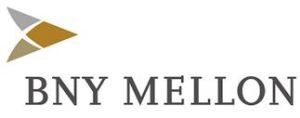 Summary
Summary
- BK is one of the 10 largest asset managers in the world on the basis of assets under management (AUM).
- Technology spend is significant in order to remain at the forefront of the industry. This makes it difficult for smaller competitors to compete directly with BK in certain lines of business.
- BK’s earnings should improve as interest rates rise.
- A drawback is that BK is subject to cyclical swings as changes in interest rates and market values directly affect income and the level of AUM and under custody; this impacts income levels.
Introduction
As noted in my March 7, 2017 post, I acquired several hundred shares in The Bank of New York Mellon Corporation (NYSE: BK) in December 2010 and several hundred more shares in September 2011; all dividends have been reinvested and my average cost is currently ~$21.
All shares are held in my wife’s Registered Retirement Savings Plan (RRSP) as opposed to the FFJ Portfolio so as to avoid the 15% withholding tax Canadians incur on US dividend income.
At the time of my March 7, 2017 post I was of the opinion the shares were slightly overvalued. The stock subsequently dropped in price but I had no idea the US markets would experience the recent dramatic run-up so my call has not been accurate.
Now that BK has released its Q4 and FY2017 results on January 18, 2017, I am taking this opportunity to determine whether it is an appropriate time to add to my BK position.
Business Overview
BK is now one of the 10 largest asset managers in the world on the basis of assets under management (AUM). As at December 31, 2017, BK had over $33.3 Trillion in assets under custody and/or administration.
The forecasted increase in interest rates and the continuous increase in regulation should bode well for BK as these factors are encouraging asset managers to outsource their back-office operations for greater security and oversight.
BK is involved at all stages in the investment lifecycle which includes, but is not limited to, the settling and storage of assets, recordkeeping, issuance, back-office solutions for asset managers, and tri-party repurchase clearing.
JP Morgan’s (NYSE: JPM) relatively recent decision to exit the tri-party repo for government securities now leaves BK as the sole player in this business. This should bode well for BK.
BK’s investment-management arm is involved in asset and wealth management. This is somewhat of a commodity like business but BK’s scale, the high barriers to entry, and the stickiness of clients work in BK’s favor.
On the January 18, 2018 conference call with analysts, BK’s Chairman and CEO indicated:
“We intend to meaningfully increase the amount we spend on technology. We know we're a bank and are proud of it, but we're different from other banks. 75% of our company is a technology-based processing business and 25% is investment management, where technology will continue to become a more important tool for success. Our technology will define our future, and we need to ensure we're investing to create the highest quality infrastructure and a platform which allows us to both drive significant efficiencies in the future as well as be agile enough to allow us to move quickly as we expand our product offerings.”
As noted by BK’s Chairman and CEO, BK spends a considerable amount on technology. At ~$2B annually, this is a level most smaller firms cannot even come close to matching.
Once the significant large up-front capital expenditures have been made to build often complex servicing platforms, there is an extremely low incremental cost of running additional services through an already built platform. This is why the largest established firms, such as BK, have an economy of scale advantage that allows them to offer services at significantly lower prices than smaller competitors. In addition, the largest and most complex clients often have unique requirements which only the largest custodians can provide. This represents a significant barrier to entry.
Another barrier to entry is that this industry is very highly regulated. In order to become a true custodian and to be a central securities depository (CSD) member, a firm is subject to, and must comply with, many of the regulations to which only banks are subject.
NOTE: A CSD is a specialist financial organization which holds securities such as shares either in certificated or uncertificated form. This permits the easy transfer of ownership through a book entry versus the transfer of physical certificates.
An additional barrier to entry is the switching costs. If you have ever experienced the challenges of having to transfer multiple and complex banking services from one financial institution to another, imagine how complex it must be for institutional clients to switch to, or from, BK.
The onboarding costs are high! In this business, it requires considerable resources to switch providers because a client’s back-office infrastructure is very often built around the current custodian’s own infrastructure. Not only are the client and the custodian so closely inter-connected, the nature of the services provided by the custodian are so critical to the client that a major interruption that is not fully resolved in very short order can be disastrous.
Asset custody (the taking possession of and providing safekeeping for financial assets) and asset servicing (the back-office support such as collection of dividends and the recording of asset values for asset managers) are examples of businesses where errors can not occur. Given the risks involved in changing service providers, clients are typically loathe risking change.
While BK does have barriers to entry working in its favor, it does face challenges. Headwinds include increased pricing pressure in asset servicing and back-office services as the main providers compete for market share.
Q4 and FY2017 Results
BK’s Q4 and FY2017 Earnings Release can be found here. BK’s results were impacted in various ways as a result of the recently legislated Tax Cuts and Jobs Act. It also took a sizable extra charge, largely due to severance expenses related to internal restructurings.


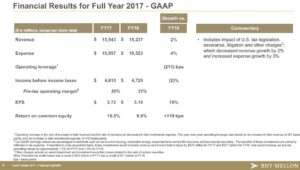
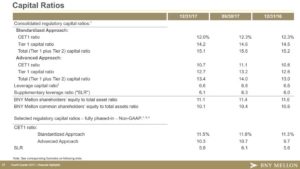
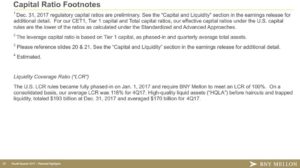 Source: BK Q4 2017 Financial Highlights – January 18, 2018 presentation
Source: BK Q4 2017 Financial Highlights – January 18, 2018 presentation
Under the leadership of its new CEO, BK has undertaken a significant shuffling of leadership and the organizational structure. Various layers of management between top management and reporting units have been eliminated and a position heading up BK’s digital efforts has been added. BK has also indicated it will be consolidating several of its formerly separate, boutique asset managers thereby helping streamline what has historically been a disjointed group.
2018 Outlook
BK’s Investor Day, originally set for November 16, 2017, has been rescheduled to March 8, 2018. The senior management team will discuss BK’s outlook and strategy at such time.
Risk
The custodial business in which BK is engaged requires a very high level of confidence. Clients want to entrust their money with a highly rated service provider engaged in the business of custodial services. BK fits the bill.
The ratings agencies rate BK’s Long-Term Senior Debt and Subordinated Debt as Upper Medium Grade with the exception of Fitch which rates BK’s Long-Term Senior Debt as High Grade. The ratings outlook from S&P, Moody’s, and Fitch are all stable.
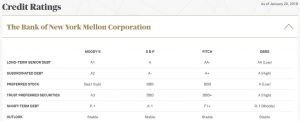 Source: BK website on January 20, 2018
Source: BK website on January 20, 2018
Berkshire Hathaway Investment in BK
In the investment world there is a group of investors defined as institutional investors; Berkshire Hathaway falls in this category. This group is the biggest component of the "smart money" group and typically consists of pension funds, endowment funds, insurance companies, commercial banks, mutual funds and hedge funds. They are regulated in the United States by the Securities and Exchange Commission (SEC) and must file a Form 13F with the SEC to report their quarterly holdings. In addition, they must file a Form 13G if they own more than 5% of a company's stock.
Institutional investors have the resources to do extensive research on wide-ranging investment options. Due to their specialized knowledge and ability to often meet personally with company executives, study entire industries, and evaluate companies in depth before making specific investment decisions, they generally have an edge over retail investors.
Given this, many retail investors will use public filings by the institutional investors to peek into what these institutions are buying or selling each quarter. They will closely scrutinize the purchases and sales of equities by the world’s most astute investors, Warren Buffett and Charlie Munger, at Berkshire Hathaway. While this information is certainly valuable, investors should be aware that Berkshire Hathaway has received special dispensation and can report its holdings well after it has executed any activity.
As a result, retail investors should not rely heavily on these Form 13Fs when making investment decisions.
Nevertheless, there is always an element of curiosity as to the outlook Buffett and Munger have on a particular company and this is why I periodically look at Berkshire Hathaway’s Form 13F filings.
The following table reflects Berkshire Hathaway’s investment in BK from the end of the quarter in which it initiated a position in BK to the end of the September 2017 quarter (most recent Form 13F available as at the date of this article).
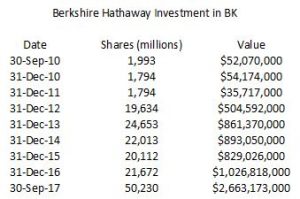 Berkshire Hathaway has certainly significantly increased its investment in BK. Looking at the table above and BK’s stock chart, it is evident that Berkshire Hathaway acquired a significant portion of its BK investment at prices much lower than the current price of $56.60.
Berkshire Hathaway has certainly significantly increased its investment in BK. Looking at the table above and BK’s stock chart, it is evident that Berkshire Hathaway acquired a significant portion of its BK investment at prices much lower than the current price of $56.60.
Dividends, Dividend Yield, and Dividend Payout Ratio
The current $0.96/annual dividend is a yield of ~1.7% based on the $56.61 closing stock price on January 19, 2018.
BK’s dividend and stock split history can be found here. As at the time of composing this article, the dividend history reported on BK’s website is outdated. The website currently reflects the most recent quarterly dividend as having been $0.19 paid May 12, 2017. This is incorrect. BK has paid a $0.24 quarterly dividend in August and November 2017 and is scheduled to pay a $0.24 quarterly dividend February 2018; this translates into a $0.96 annual dividend.
In Q4 2017, BK repurchased 12 million common shares for $0.651B and paid $0.248B in dividends to common shareholders. For FY2017, BK repurchased 55 million common shares for $2.7B and paid $0.901B in dividends.
BK’s 2000 – 2017 dividend history has been marred by a $0.15/quarter dividend cut ($0.24 reduced to $0.09) during the Financial Crisis. Looking at BK’s compound annual dividend growth rate during this period we see that the dividend growth is a paltry 1.21%.
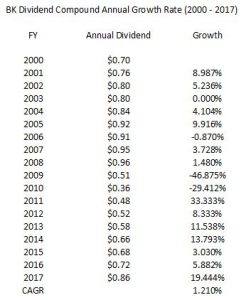 If we amend the timeframe for analysis purposes to 2010 – 2017, we get an entirely different picture.
If we amend the timeframe for analysis purposes to 2010 – 2017, we get an entirely different picture.
 BK was certainly hit hard during the Financial Crisis. While we will undoubtedly have market corrections in the future, I strongly suspect BK will be in a much better position to weather the storm. It is currently in a far better financial position today than it was at the time of the Financial Crisis, and therefore, I am cautiously optimistic we will not see a similar dramatic decline in BK’s annual dividend in the foreseeable future. I am, therefore, relying on the 2010 – 2017 13.247% compound annual dividend growth rate for analysis purposes.
BK was certainly hit hard during the Financial Crisis. While we will undoubtedly have market corrections in the future, I strongly suspect BK will be in a much better position to weather the storm. It is currently in a far better financial position today than it was at the time of the Financial Crisis, and therefore, I am cautiously optimistic we will not see a similar dramatic decline in BK’s annual dividend in the foreseeable future. I am, therefore, relying on the 2010 – 2017 13.247% compound annual dividend growth rate for analysis purposes.
FY2017 earnings per share amounted to $3.72. On this basis, the $0.96/annual dividend represents a ~26% dividend payout ratio. This low level provides BK with ample flexibility to increase its dividend in 2018.
Valuation
The current mean EPS for FY2018 from 21 analysts is $4.03 thus giving us a forward PE ratio of ~14 (using the current $56.61 stock price). This level is lower than that evidenced over the past few years but BK is not as attractively valued as in 2011 and 2012.
While investors often compare the price earnings (PE), forward price earnings (FPE), price to cash flow (P/CF), and dividend yield (DY) relative to the results for the S&P 500 in its entirety, I am of the opinion this is of little value. Comparing a company in the business of Asset Management versus a company in the Integrated Shipping & Logistics industry or in the Integrated Oil & Gas industry does not make sense.
In this regard, I am of the opinion it is preferable to compare BK to Northern Trust Corp (NASDAQ: NTRS) and State Street (NYSE: STT).
- BK’s ratios are~16.6 (PE), ~14 (FPE), ~7.4 (P/CF), ~1.5% (DY).
- NTRS’s ratios are ~23.6 (PE), ~17.3 (FPE), ~14.3 (P/CF), ~1.5% (DY).
- STT’s ratios are ~18.6 (PE), ~15.4 (FPE), ~22.1 (P/CF), ~1.5% (DY).
Source: Morningstar
Judging from the above, BK appears to be more fairly valued than NTRS and STT.
Final Thoughts
Based on my research, I:
- like that BK faces limited competition in some of its lines of business due to high entry barriers;
- am encouraged that the new Chairman and CEO is making various overdue changes to the corporate structure;
- envision the rising interest rate environment working in BK’s favor;
- like that Berkshire Hathaway has a ~$2.67B position BK.
I, therefore, intend to acquire additional BK shares at some point but not now. My concern at the moment is that there is an element of irrational exuberance which has contributed to the dramatic run up in BK’s stock price in recent months. While I do not envision a recession in the short-term, I suspect there will be some event which will present us with a more favorable BK purchase price in 2018 than the current price.
Note: I sincerely appreciate the time you took to read this post. As always, please leave any feedback and questions you may have in the “Contact Me Here” section to the right.
Disclaimer: I have no knowledge of your individual circumstances and am not providing individualized advice or recommendations. I encourage you not to make any investment decision without conducting your own research and due diligence, and consulting your financial advisor about your specific situation.
Disclosure: I am long BK.
I wrote this article myself and it expresses my own opinions. I am not receiving compensation for it and have no business relationship with any company whose stock is mentioned in this article.

